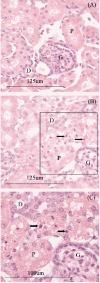The effects of asphyxia on renal function in fetal sheep at midgestation
- PMID: 12937284
- PMCID: PMC2343466
- DOI: 10.1113/jphysiol.2003.050062
The effects of asphyxia on renal function in fetal sheep at midgestation
Abstract
To determine whether damage to the fetal kidneys plays a role in the formation of hydrops fetalis following a severe asphyxial episode, six chronically catheterised fetal sheep, at 0.6 gestation (90 days; term 150 days), were subjected to 30 min of complete umbilical cord occlusion. During the occlusion period, mean arterial pressure, heart rate and renal blood flow decreased (P < 0.001). There were falls in arterial pH and PO2 and a rise in PCO2 (P < 0.001). Urine flow rate decreased (P < 0.005), as did the excretion rates of sodium and osmoles (P < 0.05). However, by 60 min after release of occlusion, urine flow rate was similar to control values. By the end of day 1, most renal variables returned to normal. At post-mortem, 72 h after occlusion, all asphyxiated fetuses showed gross signs of hydrops. Body weight was higher (P < 0.05) due to fluid accumulation in the peritoneal (P < 0.001) and pleural cavities (P < 0.05) as well as subcutaneously (P < 0.05). Amniotic/allantoic fluid volume was increased (P < 0.05). Kidney histology was normal except for clusters of apoptotic cells in some proximal tubules. In conclusion, this severe asphyxial episode caused surprisingly little damage to the kidney and the changes in renal function were very transient. Thus renal damage was not important in the development of hydrops. Possibly, the midgestation fetal kidney has a limited capacity to increase urinary salt and water excretion in response to increased fluid delivery across the placenta.
Figures









Similar articles
-
Long-term effects of a midgestational asphyxial episode in the ovine fetus.Anat Rec A Discov Mol Cell Evol Biol. 2006 Oct;288(10):1112-20. doi: 10.1002/ar.a.20381. Anat Rec A Discov Mol Cell Evol Biol. 2006. PMID: 16952168
-
The roles of arginine vasopressin in fetal sodium balance and as a mediator of the effects of fetal "stress".J Dev Physiol. 1993 Mar;19(3):125-36. J Dev Physiol. 1993. PMID: 8089438
-
Increased urinary flow without development of polyhydramnios in response to prolonged hypoxia in the ovine fetus.Am J Obstet Gynecol. 2001 Apr;184(5):1008-14. doi: 10.1067/mob.2001.112971. Am J Obstet Gynecol. 2001. PMID: 11303213
-
The relationship between heart rate and asphyxia in the animal fetus.Clin Invest Med. 1993 Apr;16(2):166-75. Clin Invest Med. 1993. PMID: 8513617 Review.
-
Effects of fetal asphyxia on brain cell structure and function: limits of tolerance.Comp Biochem Physiol A Mol Integr Physiol. 1998 Mar;119(3):711-6. doi: 10.1016/s1095-6433(98)01009-5. Comp Biochem Physiol A Mol Integr Physiol. 1998. PMID: 9683410 Review.
Cited by
-
Ketamine suppresses hypoxia-induced inflammatory responses in the late-gestation ovine fetal kidney cortex.J Physiol. 2016 Mar 1;594(5):1295-310. doi: 10.1113/JP271066. Epub 2015 Nov 15. J Physiol. 2016. PMID: 26497972 Free PMC article.
-
Serum and urine acute kidney injury biomarkers in asphyxiated neonates.Pediatr Nephrol. 2012 Sep;27(9):1575-82. doi: 10.1007/s00467-012-2162-4. Epub 2012 Apr 25. Pediatr Nephrol. 2012. PMID: 22532328
-
The many faces of hydrops.J Pediatr Surg. 2015 Jan;50(1):50-4; discussion 54. doi: 10.1016/j.jpedsurg.2014.10.027. Epub 2014 Oct 29. J Pediatr Surg. 2015. PMID: 25598092 Free PMC article.
-
Fetal hydrops in experimental obstructive uropathy resolves after vesicostomy formation: is this cause and effect?Pediatr Surg Int. 2005 Jan;21(1):25-8. doi: 10.1007/s00383-004-1257-9. Pediatr Surg Int. 2005. PMID: 15459778
-
Does Maturity Affect Cephalic Perfusion and T/QRS Ratio during Prolonged Umbilical Cord Occlusion in Fetal Sheep?Obstet Gynecol Int. 2014;2014:314159. doi: 10.1155/2014/314159. Epub 2014 Feb 16. Obstet Gynecol Int. 2014. PMID: 24693290 Free PMC article.
References
-
- Alward CT, Hook JB, Helmbrath TA, Bailie MD. Effects of asphyxia on renal function in the newborn piglet. Pediatr Res. 1978;12:225–228. - PubMed
-
- Anderson DF, Faber JJ. Animal model for polyhydramnios. Am J Obstet Gynecol. 1989;160:389–390. - PubMed
-
- Ball RH, Parer JT, Caldwell LE, Johnson J. Regional blood flow and metabolism in ovine fetuses during severe cord occlusion. Am J Obstet Gynecol. 1994;171:1549–1555. - PubMed
-
- Blair DK, Vander Straten MC, Gest AL. Hydrops in fetal sheep from rapid induction of anemia. Pediatr Res. 1994;35:560–564. - PubMed
Publication types
MeSH terms
Substances
LinkOut - more resources
Full Text Sources

